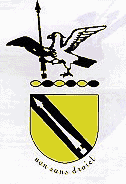The Shakespeare Coat of Arms

By Rose Reyes

By Rose Reyes
Heraldry was often associated with the crown and with politicly powerful families. But so pervasive was the importance of the whole range of heraldry that shields and badges of English monarchs, powerful barons, as well as cities and important guilds would be allowed an emblem.
Perhaps the most popular heraldic badge in Elizabethan England was the Tudor Rose, apparent everywhere, which became a major theme in Shakespeare's historical plays. Shakespeare's knowledge of heraldry is embedded deeply in his historical plays.
John Shakespeare applied for a coat of arms in 1568, after becoming bailiff of Stratford-upon-Avon. Shakespeare, in 1596, was granted a coat of arms. The grant was made out to John Shakespeare, however it was thought that William Shakespeare may have arranged everything.

Following is a heraldic written enterpretation of the shield as it would have appeared on paper. The shield was to be 'gold on a bend sables, a spear of the first steeled argent, and for his crest, a falcon, his wings displayed argent, standing on a wreath of his colors, supporting a spear gold, steeled as aforesaid, set upon a helmet with mantles and tassels.' The motto, which Shakespeare is not known to have used, is 'Non Sans Droit' - ' Not Without Right.'